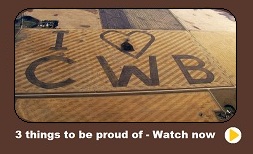Critical CWB activity may be its most important
TRADE BATTLES – Board would do well to tell producers the rest of their story on the steep cost of trade litigation
“Sure, each side in the CWB election debate will marshal its market and statistical ammunition to fire broadsides at each other. That is to be expected. But I suggest that the issue of fighting trade challenges is a sleeping elephant that needs to be recognized and appreciated. For that reason alone, we have to keep the CWB in place.
Finally, I have over the years had the opportunity to meet American and European trade officials who have all expressed disdain, fear, anger and even admiration for the CWB. The fact our competitors get this emotional over a Canadian institution should hold a clear message for Canadian producers. Just some food for thought at CWB election time.”
Mr. Verboven’s editorial appeared in the Alberta Farm Express, October 11, 2010.
Board saves cattle feedlots in west
Excerpt from “Return of the Trojan Horse” Edited by Dr. Trevor Harrison, 2005, Black Rose Books.
The often-hysterical anti-wheat board rhetoric of the Alberta Government and its check-off funded organizations did not go unnoticed south of the 49th parallel. The U.S. based Ranchers’ Cattlemen Legal Defense Fund (R-Calf) used anti-CWB propaganda that the CWB “suppressed the price of feed grains in western Canada” to make a formal complaint to the U.S. Department of Commerce that the CWB was effectively subsidizing cattle feeding in Western Canada. Its November 1998 formal submission to the Department of Commerce made heavy use of quotations from Alberta Cattle Commission (ACC) Board members and formal submissions by the ACC, the Alberta Cattle Feeders’ Association and others opposing the CWB at various hearings conducted by the Canadian and Alberta governments into grain marketing, transportation and other agricultural issues.
The U.S. Department of Commerce responded in 1998 by launching an investigation of the Canadian cattle feedlot industry and the CWB. After legal costs to the CWB and the Government of Canada amounting to millions of dollars, the U.S. Department of Commerce came to the conclusion the CWB was not a subsidy to cattle feedlots in Canada. In their preliminary report, referring to feed barley prices, they concluded: “In fact, the Canadian domestic price was actually higher in portions of the Period of Investigation (POI) and after the POI.” (Import Administration, International Trade Administration, and U.S. Department of Commerce. Final Negative Countervailing Duty Determination Live Cattle from Canada. . Washington DC: U.S. Department of Commerce, October 22, 1999. Page 25285.)
The cattle feeding industry in western Canada had come very near to destruction. (Ibid. page 57043) Ironically, the ideologically motivated rhetoric of the Alberta Government and the zealous opponents of cooperatives, including the Alberta Cattle Commission, had resulted, not in the extinction of the CWB, but in many of the existing supports to independent ranchers and cow-calf producers being deemed by this U.S. ruling as subsidies.
The government of Alberta spun this stunning and unintended consequence of its anti-CWB campaign as a response to pressures from the environmental and hunting community for access to grazing leases; access the public already enjoyed. It was a fatuous if effective distraction from the reality of ranchers facing higher grazing lease fees, the partial loss of surface access fees to their grazing leases and further costs to their community pasture and Feeder Associations precipitated by their own government’s addiction to ideology and propaganda.

